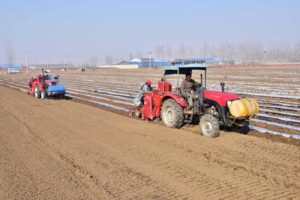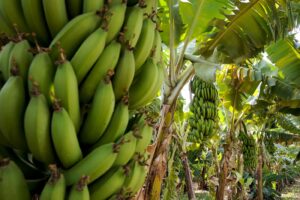Global yields of wheat are around 10% lower now than they would have been without the influence of climate change, according to a new study.
The research, published in the Proceedings of the National Academy of Sciences, looks at data on climate change and growing conditions for wheat and other major crops around the world over the past 50 years.
It comes as heat and drought have this year been putting wheat supplies at risk in key grain-producing regions, including parts of Europe, China and Russia.
The study finds that increasingly hot and dry conditions negatively impacted yields of three of the five key crops examined.
Overall, global grain yields soared during the study period due to technological advancements, improved seeds and access to synthetic fertilisers.
But these yield setbacks have “important ramifications for prices and food security”, the study authors write.
Grain impacts
Most parts of the world have experienced “significant” yield increases in staple crops since the mid-20th century.
The new study notes that, in the past 50 years, yields increased by 69-123% for the five staple crops included in the research – wheat, maize, barley, soya beans and rice.
But crop production is increasingly threatened by climate change and extreme weather. A 2021 study projected “major shifts” in global crop productivity due to climate change within the next two decades.
Earlier this year, Carbon Brief mapped out news stories of crops being destroyed around the world by heat, drought, floods and other weather extremes in 2023-24. Maize and wheat were the crops that appeared most frequently in these reports.
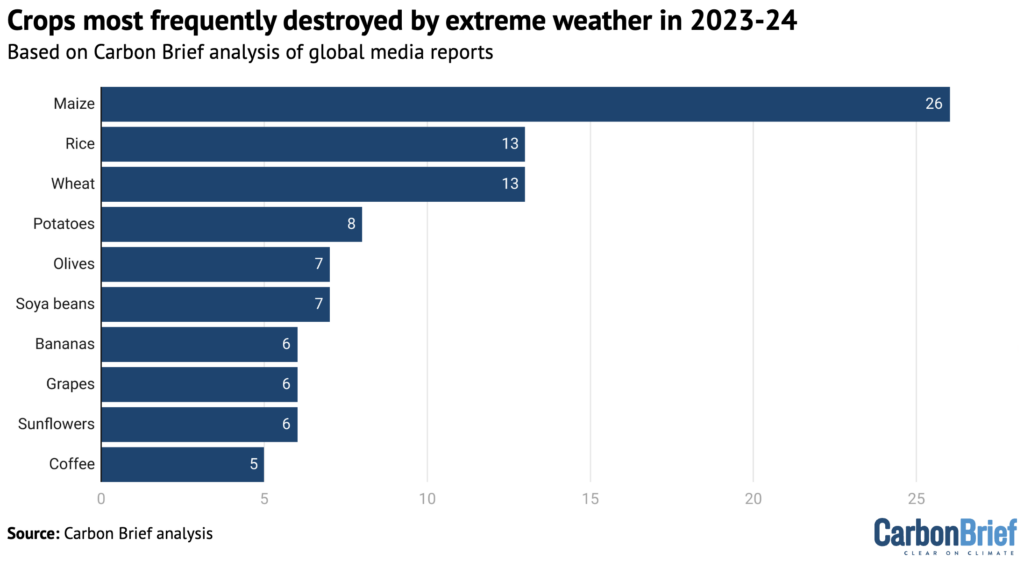
Hot and dry weather is currently threatening wheat crops in parts of China, the world’s largest wheat producer, Reuters reported this month.
In the UK, wheat crops are struggling amid the “driest start to spring in England for almost 70 years”, the Times recently reported. Farm groups say some crops are already failing, the Guardian said.
As a result, global wheat supplies are “tight”, according to Bloomberg, with price rises possible depending on weather conditions in parts of Europe, China and Russia.
Food security and prices
The study uses climate datasets, modelling and national crop statistics from the UN Food and Agriculture Organization to assess crop production and climate trends in key grain-producing countries over 1974-2023, including Argentina, Brazil, Canada, China, the EU, Russia and the US.
The researchers assess climate observations and then use crop models to calculate what yields would have been with and without these climate changes.
For example, “if it has warmed 1C over 50 years and the model says that 1C leads to 5% yield loss, we’d calculate that the warming trend caused a loss of 5%”, Prof David Lobell, the lead study author and a professor at Stanford University, tells Carbon Brief.
The study looks at two reanalysis climate datasets that include information on temperature and rainfall over the past 50 years: TerraClimate (TC) and ERA5-Land. (Reanalysis data combines observations with a modern forecasting model.)
The researchers find that yields of three of the five crops are lower than they would have been without warmer temperatures and other climate impacts in the past 50 years.
Yields were lower than they otherwise would have been by 12-14% for barley, 8-12% for wheat and 4% for maize.
The impacts on soya beans were less clear as there were “significant differences” between data sources. But both datasets show a negative impact on yields, ranging from 2% to 8%.
The effects on rice yields were inconclusive, with one dataset showing a positive effect of around 1% while the other showed a negative effect of about 3%.
The chart below shows the estimated yield impacts for each crop based on the calculations from the two climate datasets.

Given soaring overall crop yields during this time, impacts of 4-13% “may seem trivial”, the researchers write. But, they say, it can have “important ramifications for prices and food security” given growing food demand, noting:
“The overall picture of the past half-century is that climate trends have led to a deterioration of growing conditions for many of the main grain-producing regions of the world.”
Water stress and heat
The study also assesses the impacts that warming and vapour pressure deficit – a key driver of plant water stress – have on crop yields.
Vapour pressure deficit is the difference between the amount of water vapour in the air and the point at which water vapour in the air becomes saturated. As air becomes warmer, it can hold more water vapour.
A high deficit can reduce plant growth and increase water stress. The models show that these effects may be the main driver of losses in grain yield, with heat having a more “indirect effect”, as higher temperatures drive water stress.

The study finds that vapour pressure deficit increased in most temperate regions in the past 50 years.
The researchers compare their data to climate modelling simulations covering the past 50 years. They find largely similar results, but notice a “significant underestimation” of vapour pressure deficit increases in temperate regions in most climate models.
Many maize-growing areas in the EU, China, Argentina and much of Africa have vapour deficit trends that “exceed even the highest trend in models”, they write.
The researchers also find that most regions experienced “rapid warming” during the study period, with the average crop-growing season now warmer than more than 80% of growing seasons 50 years ago.
The findings indicate that, in some areas, “even the coolest growing season in the present day is warmer than the warmest season that would have occurred 50 years ago”.
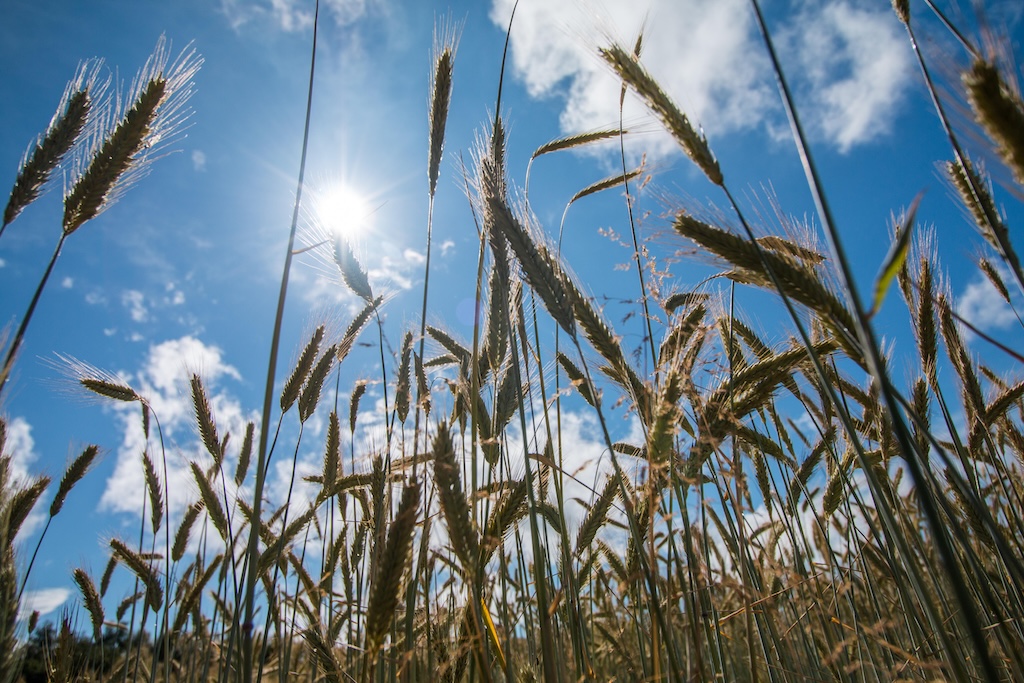
An exception to this is in the US and Canada, they find, with most maize and soya bean crop areas in the US experiencing lower levels of warming than other parts of the world and a “slight cooling” in wheat-growing areas of the northern Great Plains and central Canada.
(The central US has experienced a cooling trend in summer daytime temperatures since the middle of the 20th century, according to the National Oceanic and Atmospheric Administration. There are many theories behind this “warming hole”, which has continued despite climate change.)
CO2 greening
Dr Corey Lesk, a postdoctoral researcher at Dartmouth College who studies the impacts of climate on crops, says these findings are in line with other recent estimates. He tells Carbon Brief:
“There are some uncertainties and sensitivity to model specification here – but it’s somewhat likely climate change has already reduced crop yields in the global mean.”
The study’s “main limitation” is that it is “behind” on including certain advances in understanding how soil moisture impacts crops, Lesk adds:
“Moisture changes and CO2 [carbon dioxide] effects are the largest present uncertainties in past and future crop impacts of climate change. This paper is somewhat limited in advancing understanding on those aspects, but it’s illuminating to pause and take stock.”
The research looks at whether the benefits of CO2 increases during the past 50 years exceed the negative effects of higher levels of the greenhouse gas.
Rising CO2 levels can boost plant growth in some areas in a process called “CO2 fertilisation”. However, a 2019 study found that this “global greening” could be stalled by growing water stress.
Yield losses for wheat, maize and barley “likely exceeded” any benefits of CO2 increases in the past 50 years, the study finds.
The opposite is true for soya beans and rice, they find, with a net-positive impact of more than 4% on yields.

Climate science has “done a remarkable job of anticipating global impacts on the main grains and we should continue to rely on this science to guide policy decisions”, Lobell, the lead study author, says in a press release.
He adds that there may be “blind spots” on specialised crops, such as coffee, cocoa, oranges and olives, which “don’t have as much modelling” as key commodity crops, noting:
“All these have been seeing supply challenges and price increases. These matter less for food security, but may be more eye-catching for consumers who might not otherwise care about climate change.”
The post Global wheat yields would be ‘10%’ higher without climate change appeared first on Carbon Brief.
Global wheat yields would be ‘10%’ higher without climate change
Climate Change
Week One at COP30: Reflections from the Amazon
Standing in the Blue Zone in Belém, Brazil, surrounded by thousands of negotiators, activists, scientists, and Indigenous leaders, I’m struck by how profoundly location shapes conversation. This is the first COP held in the Amazon rainforest—not symbolically nearby, but actually within it.
Through Climate Generation’s support, I’m able to spend two weeks here building strategic relationships and supporting mission-driven organizations. Their partnership — rooted in a mission to ignite and sustain the ability of educators, youth, and communities to act on systems perpetuating the climate crisis — enables Terra40 to deliver strategic event campaigns that include comprehensive Event Planning, Marketing, and Delegation Management to organizations like HBCU Green Fund at COP30.
Here’s what the first week has taught me.
The Beautiful Congregation
One of my favorite aspects of global forums is the congregation itself: diverse nations, peoples, and languages weaving together in one space. You hear Portuguese, Spanish, French, Chinese, Indigenous languages, Arabic — all at once. It’s a powerful reminder that we’re interconnected yet unique, each bringing something distinct to the table, yet all here for the same urgent purpose. But that diversity isn’t just poetic — it’s strategic. Different cultures approach negotiation, relationship building, and decision-making in fundamentally distinct ways. Understanding these differences determines whether you can build coalitions that actually drive policy change. For Climate Generation’s work with educators and youth, teaching students about these diverse approaches prepares them to be more effective climate advocates.
Indigenous Leadership Takes Center Stage
The most significant shift at COP30 is the centrality of Indigenous voices. In previous COPs, Indigenous peoples often felt relegated to side events. Here in Belém, they’re in the negotiating rooms, leading pavilions, and setting the agenda.
Indigenous leaders from Brazil, Peru, Ecuador, and beyond are presenting traditional ecological knowledge that challenges and complements Western scientific frameworks. They’re not asking for a seat at the table — they’re reminding everyone that this is their table, their land, their knowledge systems that have sustained these ecosystems for millennia.
This directly connects to acting on systems perpetuating the climate crisis—one of those systems is the marginalization of Indigenous knowledge in climate solutions. For Minnesota classrooms, this means teaching students that climate solutions already exist in communities worldwide. Our job is to listen, learn, amplify, and support.
The Unglamorous Reality
Let me be honest about what Week One actually looked like: jet-lagged client meetings, navigating a massive venue, negotiations stretching past midnight, building relationships over coffee in crowded corridors, and adjusting strategy in real-time. Global forums look polished from the outside. Inside, they’re an organized chaos that requires flexibility, cultural competence, strategic thinking, and stamina. But this is also where the magic happens — where an environmental justice leader from Louisiana connects with an Indigenous forest guardian from Acre, where relationships form that outlast the two-week conference.
This messiness matters for climate education. Real climate action isn’t always tidy. It’s a mix of coalition-building, compromise, setbacks, breakthroughs, exhaustion, and hope. Preparing young people for this reality — while sustaining their ability to act — is precisely what Climate Generation’s mission describes.
Connecting Global to Local
What does COP30 mean for Climate Generation’s work with Minnesota educators, youth, and communities?
- Local solutions matter globally. Minnesota’s work on agricultural climate adaptation and renewable energy transition is part of conversations happening here. Small-scale innovations can influence international policy.
- Relationship-building is a strategy. Just like at COP30, meaningful climate work requires cultural intelligence, trust-building, and long-term relationship investment—not just data and messaging.
- Diverse voices strengthen solutions. Climate Generation’s vision of ‘a just and abundant world beyond climate crisis’ requires centering voices often marginalized: Indigenous communities, communities of color, rural communities, and young people.
- Personal connection drives action. The most effective negotiators here connect abstract targets to individual experience. This transforms information into action—exactly what Climate Generation does in Minnesota classrooms and communities.
Looking Ahead
As we head into Week Two, negotiations intensify. I’ll continue sharing insights through this partnership — because understanding how global climate policy happens should be accessible to everyone, from international negotiators to teachers in Minnesota. The climate crisis is global. But so are the solutions, relationships, and movements being born here in Belém. When educators, youth, and communities in Minnesota learn from these global convenings, they’re better equipped to act on the systems perpetuating the crisis — right where they are.
___
Fuzieh Jallow is the Founder & CEO of Terra40. This blog was written in partnership with Climate Generation
About This Partnership: Climate Generation provided COP30 credentials to Terra40 in exchange for on-the-ground insights and educational content. Learn more at climategen.org. Follow Terra40 @terra40global for real-time COP30 updates.
The post Week One at COP30: Reflections from the Amazon appeared first on Climate Generation.
Climate Change
COP30: Spain’s unions say just transition means renewing communities beyond jobs
Unions in Spain are calling for a new just transition strategy that goes beyond plant closures to revive the fabric of life in affected regions, linking public services with jobs and investment.
“When a power plant closes in a rural area, you don’t just lose jobs,” said Manuel Riera of UGT, one of Spain’s largest unions. “You risk losing the life of the place – the families, the neighbours, the school, the bus line. To keep people rooted, we have to rebuild whole economies.”
The end goal is to safeguard workers, diversify rural economies, and keep families rooted.
Spain’s breakthrough: dialogue and territorial pacts
Spain is among the few countries to have managed coal closures through negotiated territorial pacts. Since 2018, 15 agreements have been signed between national, regional and local governments in areas hit by mine and power plant shutdowns. The government also reached tripartite accords with unions and coal companies, guaranteeing solutions for affected workers.
“For the first time, workers and their communities had a seat at the table. It demonstrated that a just transition is possible and that social dialogue with trade unions must be the first step” Riera said. “That gave people dignity in a moment of loss.”
These frameworks funded retraining, supported job-creating projects and ensured public participation. They became an international reference for how social dialogue can guide decarbonisation.
A just transition for renewables: Why COP30 must put people before power
Lessons learned: from energy to social transition
But the experience has also exposed key limits. Job creation alone has not been enough to sustain rural life.
“Again and again we heard: in addition to employment, what decides if families stay is whether there is transport, housing, health care, education,” Riera said. “That is what keeps a territory alive. We have to move from an energy transition to a social transition.”
Judit Carreras Garcia, director of the Instituto para la Transición Justa (ITJ), reflected on the government’s efforts to respond to these challenges:
“Over the years, we have sought to make the just transition a reality through concrete policies and actions — walking the talk through a wide range of measures that include employability schemes, training, funding lines for job-creating business initiatives, just transition energy tender grids, municipal support programmes and environmental restoration,” she explained.
“All of them aim at minimising the impacts of decarbonisation and optimising outcomes based on participation and social dialogue. This effort has come with its own challenges — from managing timing gaps to addressing very different territorial starting points — but our commitment remains firm.”
Both unions and government acknowledge that anticipation is crucial: closures must be aligned with new opportunities, and support must adapt to vastly different territorial realities – from regions facing depopulation to those with stronger infrastructure.


The next phase for just transition
UGT is now working with its federations to shape Spain’s next Just Transition Strategy (2026–2030). Visits to pact areas, including Aragón, where a coal plant closed in 2020, reveal a rising sense of frustration.
“People are tired of waiting,” Riera said. “We have projects on paper, but they don’t see them materialising. Without effective coherent planning, workers retrain and then have to move to Madrid or Barcelona. That is not territorial justice.”
The unions’ demand: keep the territorial approach, but expand it across ministries and sectors, ensuring that services and infrastructure grow alongside jobs.
For Indian women workers, a just transition means surviving climate impacts with dignity
Behind the technical debates lies a deeper fear: the hollowing out of rural Spain, where thousands of villages have already lost their young people and their future. A mishandled transition could accelerate that trend.
“This is not only about jobs,” Riera said. “It is about whether towns survive at all. When a power station shuts, it’s not just the jobs inside the gates that disappear. The bus stops running, the school risks closing, the clinic can’t keep going, housing starts to deteriorate. Families leave, and a town empties. And once they leave, they rarely come back.”
Sharing lessons internationally
In September, Riera met unions from around the world to share Spain’s experience. His message was simple: we must fight for social dialogue and territorial agreements, but these are the beginning — not the end — of a just transition.
“If decisions are only made in the capital, they miss what life is like in a village. What Madrid sees as energy policy, a small town sees as survival: will there still be a bus, a clinic, a school? That is why workers and communities must always be in the room.”
For Riera, the work that goes into the just transition is also a chance to imagine something new.
“We can use this moment not just to protect people from loss, but to renew rural life — to make villages places where families want to stay, where children can imagine their future. This is about dignity, but also about love: love of place, love of community, love of life itself.”
“Water is worth more than lithium,” Indigenous Argentine community tells COP30
A call for Belém – and beyond
Now in Belém for COP30, Riera is bringing a clear message to world leaders: Spain’s experience shows that the just transition must be built from the ground up. The Belém Action Mechanism that has been proposed, he argues, should require cross-sector transition plans – not just energy policies; guarantee participation from workers and communities; and secure public finance capable of delivering not only jobs but the services that sustain life around them.
“The Global South faces the same challenge: how to transition without abandoning people. Without public finance, that is impossible,” he said. “If we treat the just transition as a bargaining chip, we betray them. But if we take it seriously, we can create hope — from Spain to Brazil, from Santander to Belém.”
“This is not only about closing coal or opening renewables,” he added. “It is about whether people can imagine a future for their children. That is what the just transition means.”
The post COP30: Spain’s unions say just transition means renewing communities beyond jobs appeared first on Climate Home News.
COP30: Spain’s unions say just transition means renewing communities beyond jobs
Climate Change
COP30 Bulletin Day 6: COP’s climate march takes to the streets again
Indigenous peoples, climate activists, feminist organisations, clowns, friars, cyclists and more came together on Saturday under Belém’s baking sun for the “Great People’s March”, a demonstration demanding climate justice and territorial protection.
Thousands joined the first march outside the COP venue in four years, as the last three summits were held in Egypt, the United Arab Emirates and Azerbaijan, places where street protests outside the COP venue were not permitted by the authorities.
Week 1 of COP30 ends with uneven progress and many thorny issues still unresolved. Want clarity on what’s at stake? Sign up for our Monday event.
Saturday’s march in Belém ended peacefully at the Aldeia COP, a village designated by the Brazilian government to host the more than 3,000 Indigenous people who travelled to attend the conference.
During the first week of COP, it was mainly Indigenous people who led the two biggest civil society actions: a flotilla sailing on the Amazon River delta on Wednesday and a blockade of the conference centre’s entrance on Friday. Thousands also participated on Saturday.
The props seen at the march included a statue of US President Donald Trump riding on the back of a worker and a figure of Brazilian President Luiz Inácio Lula da Silva using a straw to drink “oil from the Amazon”. A network of green groups dressed in black staged a funeral for fossil fuels, carrying three huge coffins emblazoned with coal, oil and gas.
One of the Indigenous leaders present, Nelson of the Amazon Munduruku people – who organised the blockade of the COP venue entrance – said they were here “to fight, to bring the people’s vindication of resistance and struggle,” and reiterated their demand for a meeting with President Lula.
The soundtrack to the march changed from group to group of marchers, ranging from Indigenous chants and Brazilian music to shouts of Free Palestine and Free Congo.
Adaptation talks held hostage by finance
Finalising a list of 100 metrics to measure progress on adapting to more extreme weather and rising seas after two years of work may have seemed like a relatively straightforward technical win for the UN climate summit in Belém. The COP30 presidency were hoping they might even get it wrapped up in week one of the talks, which winds up on Saturday.
No such luck, as the negotiating groups for Africa, Latin America and the Arab countries have decided they want to use the talks on indicators for the Global Goal on Adaptation as a place to press for more funding from wealthy governments. Earlier in the week, as we reported, they asked for two more years to discuss the metrics, which include “means of implementation” – code for how adaptation will be paid for.
By the mid-point of the talks – when negotiators compile their work into texts that are either ready to be approved or need further refinement by ministers who arrive on Monday – the latest version of the adaptation text was entirely inside square brackets, meaning that none of it has yet been agreed among countries. It will now fall to the presidency to find a way forward.
The text they’ve been handed shows no sign of any convergence of views, and includes two main options on adaptation finance – one which would have nothing at all and the other which reflects developing-country proposals for a new quantitative goal of either $120 billion (from the Least-Developed Countries) or $150 billion (Arab Group) a year by 2030.
Under a current target set at COP26 in 2021, donor governments pledged to deliver at least $40 billion a year by 2025. But with aid budgets being cut by many, current predictions are that they are on track to deliver little more than $25 billion, which leaves a huge gap compared with needs.
Global South’s climate adaptation bill to top $300 billion a year by 2035: UN
Parts of the proposed text released on Saturday also aim to prevent developing countries from being expected to fund their own adaptation measures and say that the indicators would be voluntary and left to countries to decide how to use them, in a bid to avoid being told what they should do to make their agriculture, water and health systems and other infrastructure more resilient.
Debbie Hillier, Mercy Corps’ UNFCCC policy lead, noted that the new text brings together the full spectrum of positions raised by negotiators. “The large number of options and brackets underscores how much work still lies ahead and how crucial ministerial engagement will be in resolving the core political divergences,” she said.
She pointed to the reference to providing at least $120 billion in adaptation finance for developing countries as a signal that “pressure is mounting for a serious response to the scale of adaptation needs,” adding that the text “recognises the urgency of delivering additional and predictable public finance”.
On Friday, African Group of Negotiators Chair Richard Muyungi told Climate Home News that a two-year extension of discussions on the metrics may not be needed if there is political will to unlock more funding for adaptation.
“[If] we get the means of implementation in the indicators, I think we’ll be able to agree [them] within the shortest time possible,” he added.
While adaptation finance has erupted as an issue in the discussions on the metrics, negotiators on this track don’t actually have a mandate to decide finance matters. That is why the hot topic of whether and how to set a new target is also part of talks on the broader finance goal (NCQG) that was decided in Baku last year.
Sources told Climate Home News it may be more likely that adaptation could be allocated a share of the $300 billion a year developed countries agreed to mobilise for poorer nations by 2035 under the NCQG.


Future of $1.3-trillion roadmap uncertain at COP30
COP30 President André Corrêa do Lago today hosted a much-anticipated event on the Baku-Belém Roadmap, a document building on last year’s finance COP. It is meant to chart a way forward to meet a new goal to deliver $1.3 trillion-a-year for developing nations by 2035. But experts said the session failed to provide clear guidance and raised concerns that the roadmap could die in Belem.
The event, which is not part of formal negotiations, was originally scheduled for Tuesday but got pushed back to the weekend after countries failed to decide whether to start a conversation on finance at COP30.
Seven speakers – among them UN climate chief Simon Stiell – read statements for the first half of the 40-minute event, reiterating the roadmap’s main points — a shopping list of measures that could deliver the $1.3 trillion. A handful of governments and observers gave mostly positive feedback.
Ali Mohamed, special climate envoy of Kenya, proposed incorporating its short-term recommendations in the decisions made at COP30. One of those recommendations invites developed countries to consider working together on a delivery plan to achieve the $300 billion they are due to mobilise annually by 2035.
China’s delegate Chen Zhihua told the event that “greater clarity is needed on the implementation path” of that goal.
Corrêa do Lago emphasised that only the $300-billion core goal approved in Baku “is in the process of negotiation” and that the roadmap to 1.3T “is still something open”.
Roadmap to $1.3 trillion seeks to tip climate finance scales but way forward unclear
A representative of Colombia said, on behalf of the AILAC group of Latin American countries, that the report confuses actions to support developing countries with actions to transform all financing flows, and requested to discuss it formally in the UN climate regime.
Some observers were critical of the Brazil-led event at COP30, arguing that it risks leaving the formal negotiations with no clear guidance on finance.
“What happened today was not a conversation. It was not even a format that allows interaction with the presidency,” said Sandra Guzmán, director of the nonprofit Climate Finance Group for Latin America and the Caribbean (GFLAC).
She added that not enough developing countries were represented because at the time climate finance negotiators were in other rooms, attempting to carry the talks forward.
Joe Thwaites, senior climate finance advocate at the Natural Resources Defense Council (NRDC), said the risk of lacking clear guidance is that developed countries could fail to deliver the finance goal, as happened in the past with a previous $100bn goal that was delivered two years late. “I’m really worried that we’re going to be in the same position for the $1.3 trillion, which is a goal 13 times the size,” he added.
Azerbaijani lead finance negotiator Elmaddin Mehdiyev told Climate Home that the mandate to deliver the Baku-Belem roadmap has been completed and focusing on implementation is now “much more important”.
He added that getting the roadmap endorsed or welcomed formally by governments at COP30 was not key to taking it forward as it is a “non-negotiated document”.
Asked about this possibility after the event, Corrêa do Lago told Climate Home News: “There’s a movement starting, but we’ll see how the countries react. I think it’s unlikely to happen in Belém.”
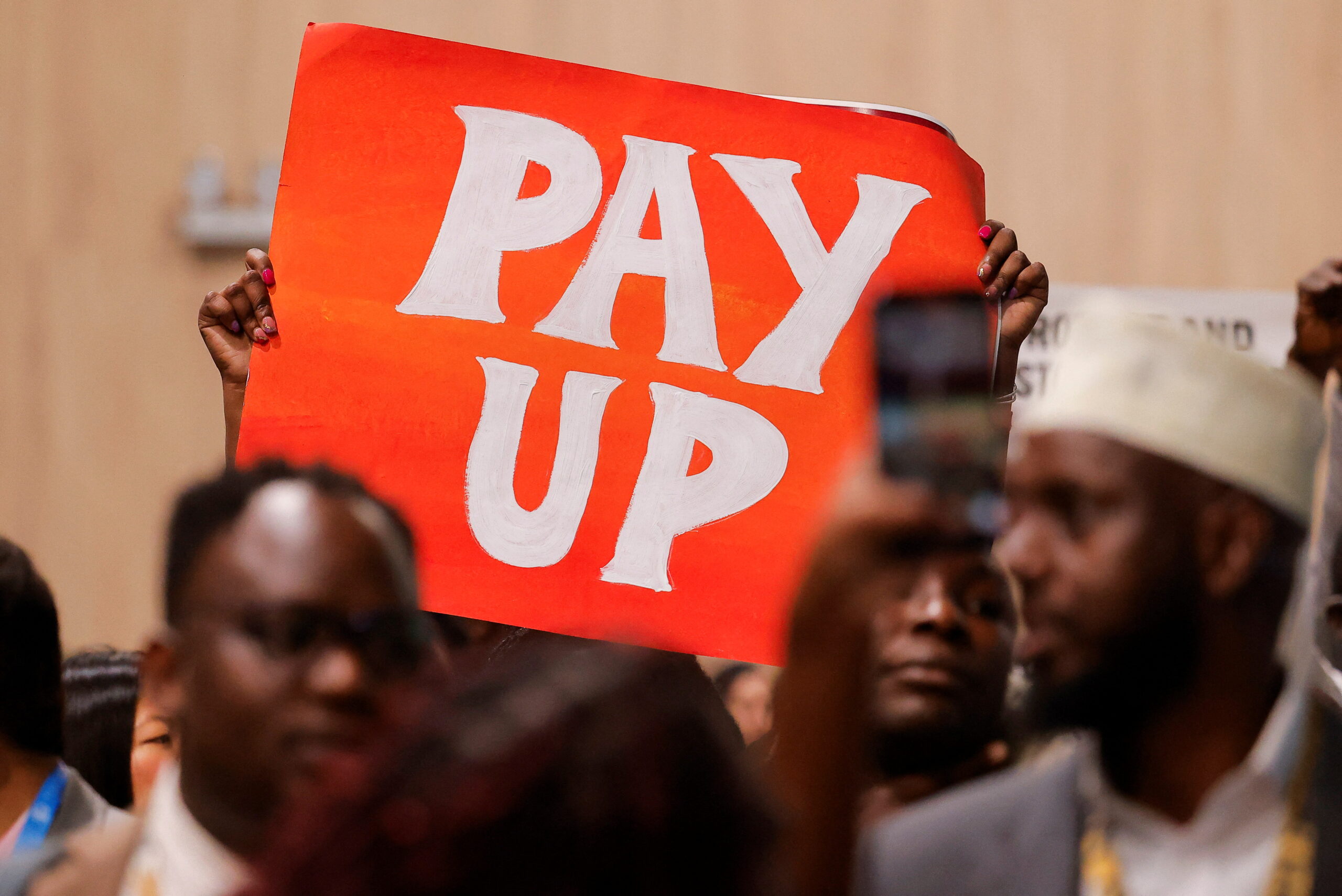

Brazil launches flagship climate and trade forum
The COP30 presidency this Saturday launched a forum for countries to discuss climate and trade, seen by Brazil as one of its “flagship” initiatives outside of the formal talks.
Trade has been one of the most contentious issues at the summit in Belém, after the Like Minded group of emerging economies pushed for an agenda item on the topic at the start of the UN climate talks.
Several countries in that group – among them China, India and Iran – have been hit by US or European trade restrictions such as the recent US tariffs on solar imports. “Collaboration remains the only viable path to solving the global crisis; only through unity can we overcome it,” said Li Gao, China’s head of delegation at the launch event for the Integrated Forum on Climate Change and Trade (IFCCT).
After a week of consultations, countries have yet to agree on whether to hold such a conversation at COP30 and the first reactions to the IFCCT were lukewarm. A senior EU negotiator said on Wednesday that the bloc does not want to address trade disputes at COP that belong in the World Trade Organization.
For now, the Brazil-led forum is in a consultation phase, including on “modalities and thematic focus”, according to its official website. The IFCCT is intended to run for an initial phase of three years from early 2026 to end 2028 and is open for countries to join, it says.
The post COP30 Bulletin Day 6: COP’s climate march takes to the streets again appeared first on Climate Home News.
COP30 Bulletin Day 6: First week ends with a colourful march and much work left to do
-
Climate Change3 months ago
Guest post: Why China is still building new coal – and when it might stop
-
Climate Change2 years ago
Spanish-language misinformation on renewable energy spreads online, report shows
-
Greenhouse Gases3 months ago
Guest post: Why China is still building new coal – and when it might stop
-

 Greenhouse Gases1 year ago
Greenhouse Gases1 year ago嘉宾来稿:满足中国增长的用电需求 光伏加储能“比新建煤电更实惠”
-
Climate Change Videos2 years ago
The toxic gas flares fuelling Nigeria’s climate change – BBC News
-

 Climate Change1 year ago
Climate Change1 year ago嘉宾来稿:满足中国增长的用电需求 光伏加储能“比新建煤电更实惠”
-

 Carbon Footprint2 years ago
Carbon Footprint2 years agoUS SEC’s Climate Disclosure Rules Spur Renewed Interest in Carbon Credits
-
Renewable Energy4 months ago
US Grid Strain, Possible Allete Sale

